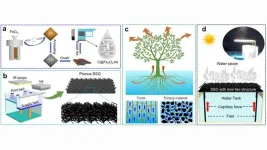(Press-News.org) A single laboratory-based HIV viral load test used by U.S. clinicians who provide people with long-acting, injectable cabotegravir (CAB-LA) HIV pre-exposure prophylaxis (PrEP) did not reliably detect HIV in a multi-country study. In the study, a single positive viral load test was frequently found to be a false positive result. However, a second viral load test with a new blood sample was able to distinguish true positive results from false positive results for all participants whose initial viral load test was positive. The findings were presented at the 2024 International AIDS Conference (AIDS 2024) in Munich, Germany.
“We are still learning how to optimize the package of services that accompany long-acting PrEP, including HIV testing,” said Jeanne Marrazzo, M.D., M.P.H., director of the National Institutes of Health’s (NIH) National Institute of Allergy and Infectious Diseases (NIAID). “The viral load testing findings observed in this study illuminate performance gaps in the current U.S. HIV testing algorithm for injectable cabotegravir PrEP.”
Long-acting, injectable cabotegravir PrEP, known as CAB-LA, is a highly effective HIV prevention method, administered by intramuscular injection every two months. Routine HIV status monitoring is recommended for any form of PrEP to ensure that people can promptly be aware if they acquire HIV while taking PrEP drugs. In the United States, people taking oral PrEP can do this with point-of-care rapid tests and self-tests that detect HIV antibodies, or laboratory-based HIV testing. However, the Food and Drug Administration (FDA) and the Centers for Disease Control and Prevention (CDC) recommend that people starting or taking CAB-LA PrEP receive a laboratory-based viral load test that detects HIV genetic material in the blood. This recommendation was made because CAB-LA can keep HIV antibodies at such low levels following acquisition that they might not be detected on an antibody-based test. To better inform the U.S. CAB-LA PrEP HIV testing algorithm, researchers examined the accuracy of viral load test results in an open-label extension of a large CAB-LA PrEP efficacy study.
The open-label study extension followed 2,620 gay, bisexual, and other men who have sex with men as well as transgender women who have sex with men from the original study population. Twenty-nine participants acquired HIV during the study extension. In five of those 29 participants (17.2%), HIV was first identified by an isolated positive viral load test result. Of these five, two had received CAB-LA in the previous six months, while three had not received CAB-LA for more than six months. The remaining 24 participants had multiple positive tests that identified the presence of HIV. Separately, 23 other participants had an isolated positive viral load test result, but 22 were later found to be HIV-negative in confirmatory testing, meaning their initial result was a false positive. One person’s status could not be determined at the time of analysis.
These data indicate that a single positive viral load test alone had a 9.1% positive predictive value—that is, a 9.1% chance of being true HIV acquisition rather than a false positive—in study participants whose last CAB-LA injection was within six months, and a 60% positive predictive value in participants whose last CAB-LA injection had been more than six months ago. Notably, the positive predictive value increased to 100% when study participants had a second round of confirmatory viral load testing with a new blood sample, regardless of the timing of their last CAB-LA injection.
“A false positive can result in PrEP interruptions that create potential vulnerability to HIV acquisition, and more importantly causes profound psychological distress while a person awaits confirmatory results from a second test,” said study chair Raphael Landovitz, M.D., professor of medicine in the Division of Infectious Diseases at the David Geffen School of Medicine at the University of California, Los Angeles. “These concerns need to be balanced against the anticipated benefits of slightly earlier HIV detection.”
Previous analyses from this study showed combinations of two antibody-based tests had positive predictive values of between 83-100% in participants receiving CAB-LA PrEP. According to the authors, these findings help fill evidence gaps about the performance of available HIV testing tools to optimize CAB-LA PrEP implementation and global scale-up. The global NIAID-supported CAB-LA studies continue to inform HIV prevention policy and practice.
NIAID supports this open-label extension study with ViiV Healthcare, Gilead Sciences, Inc., and the NIH-funded HIV Prevention Trials Network (HPTN). NIAID and ViiV Healthcare co-fund the trial, which is conducted by the HPTN. ViiV Healthcare and Gilead Sciences, Inc., provide study medications. The NIH National Institute of Mental Health, NIH National Institute on Drug Abuse, NIH Eunice Kennedy Shriver National Institute of Child Health and Human Development collaborate with NIAID on this study.
More information about the study, called HPTN 083, is available on ClinicalTrials.gov under identifier NCT02720094.
Reference:
RJ Landovitz et al. Performance characteristics of HIV RNA screening with long-acting injectable cabotegravir (CAB-LA) pre-exposure prophylaxis (PrEP) in HPTN. International AIDS Conference. Tuesday, July 23, 2024.
NIAID conducts and supports research—at NIH, throughout the United States, and worldwide—to study the causes of infectious and immune-mediated diseases, and to develop better means of preventing, diagnosing and treating these illnesses. News releases, fact sheets and other NIAID-related materials are available on the NIAID website.
About the National Institutes of Health (NIH): NIH, the nation's medical research agency, includes 27 Institutes and Centers and is a component of the U.S. Department of Health and Human Services. NIH is the primary federal agency conducting and supporting basic, clinical, and translational medical research, and is investigating the causes, treatments, and cures for both common and rare diseases. For more information about NIH and its programs, visit https://www.nih.gov/.
NIH...Turning Discovery Into Health®
END
NEWPORT NEWS, VA - A pocket-size gizmo that puts the “pop” in microwave popcorn could soon fuel particle accelerators of the future.
The small but mighty device is a magnetron – a mashup of the words “magnetic” and “electron.” The term was coined in 1921, and the technology was once a wartime secret before making its way into billions of homes as the heart of the modern microwave oven.
Now, physicists and engineers at the U.S. Department of Energy’s Thomas ...
Johns Hopkins Medicine researchers have published new research that reports on a potential alternative and less-invasive approach to measure intracranial pressure (ICP) in patients.
This research was published July 12 in the journal Computers in Biology and Medicine.
ICP is a physiological variable that can increase abnormally when one has acute brain injury, stroke or obstruction to the flow of cerebrospinal fluid. Symptoms of elevated ICP may include headaches, blurred vision, vomiting, changes in behavior and decreased level of consciousness. ...
Stockholm3, a prostate cancer test developed in Sweden, runs a combination of protein and genetic markers from a blood sample through an algorithm to find the probability of a patient having clinically significant cancer.
Studies in more than 90,000 men have shown that Stockholm3 produces significantly better results than the current PSA standard. The test improves prostate cancer diagnosis by reducing unnecessary MRI and biopsies and by identifying significant cancers in men with low or normal PSA values.
However, previous studies have been conducted primarily in Scandinavia ...
Lehigh University structural engineering alum Xu Han ’23 PhD and his doctoral advisor Professor Dan M. Frangopol have been awarded the 2024 Alfred Noble Prize, an esteemed interdisciplinary award from a consortium of professional societies, administered by the American Society of Civil Engineers (ASCE).
“I feel very humbled for receiving such a prestigious award and am very grateful to people nominating me,” says Han, who is now a postdoctoral research fellow at Texas A&M University.
Frangopol, Lehigh’s inaugural Fazlur R. Khan Endowed Chair of Structural Engineering and Architecture, is a world-renowned expert ...
WASHINGTON, July 23, 2024 — Faced with the world’s impending freshwater scarcity, a team of researchers in Singapore turned to solar steam generators (SSGs), which are emerging as a promising device for seawater desalination. Desalination can be a costly, energy-intensive solution to water scarcity. This renewable-powered approach mimics the natural water cycle by using the sun’s energy to evaporate and isolate water. However, the technology is limited by the need to fabricate complex topologies to increase the surface area necessary to achieve high water evaporation efficiency.
To overcome this ...
WASHINGTON, July 23, 2024 – Today’s athletes are always on the lookout for new techniques and equipment to help them train more effectively. Modern coaches and sports trainers use intelligent data monitoring through videos and wearable sensors to help enhance athletic conditioning. However, traditional video analysis and wearable sensor technologies often fall short when tasked to produce a comprehensive picture of an athlete’s performance.
In APL Materials, by AIP Publishing, researchers from Lyuliang University developed ...
About The Study: This cross-sectional study of electronic health record (EHR) data found that female surgeons spent more time documenting patient encounters, wrote longer notes, and spent more time in the EHR system compared with male surgeons. These findings have important implications for understanding the differential burdens faced by female surgeons, including potential contributions to burnout and payment disparities.
Corresponding Author: To contact the corresponding author, Corinna Zygourakis, ...
About The Study: In this cross-sectional study of micromobility vehicles, an increased number of injuries and hospitalizations was observed with electric vehicles compared with conventional vehicles from 2017 to 2022. These findings suggest the need for change in educational policies, infrastructure, and law to recenter on safety with the use of micromobility vehicles.
Corresponding Author: To contact the corresponding author, Benjamin N. Breyer, M.D., M.A.S., email benjamin.breyer@ucsf.edu.
To access the embargoed study: Visit our For The Media website at this link https://media.jamanetwork.com/
(doi:10.1001/jamanetworkopen.2024.24131)
Editor’s ...
Despite rapid advances in genetic testing in recent decades, more than half of people worldwide with suspected Mendelian genetic disorders do not have an accurate molecular diagnosis. Others endure more than six years of tests before a diagnosis is given. Now, KAUST researchers and scientists across Saudi Arabia have developed NanoRanger, an accurate and rapid method for genetically diagnosing such diseases in a few hours[1].
“Precise, efficient genomic diagnosis is urgently needed to improve patient outcomes and facilitate carrier ...
Electric Scooter and Bike Accidents Are Soaring Across the U.S.
National UCSF study finds some injuries and hospitalizations from popular micromobility vehicles have doubled.
In the crowded urban landscape, where small electric vehicles – primarily scooters and bicycles – have transformed short distance travel, UC San Francisco researchers are reporting a major national surge in accidents tied to “micromobility.”
E-bicycle injuries doubled every year from 2017 to 2022, while e-scooter injuries rose by 45 percent. Injured e-riders tended to be slightly older and wore helmets less often than conventional ...





